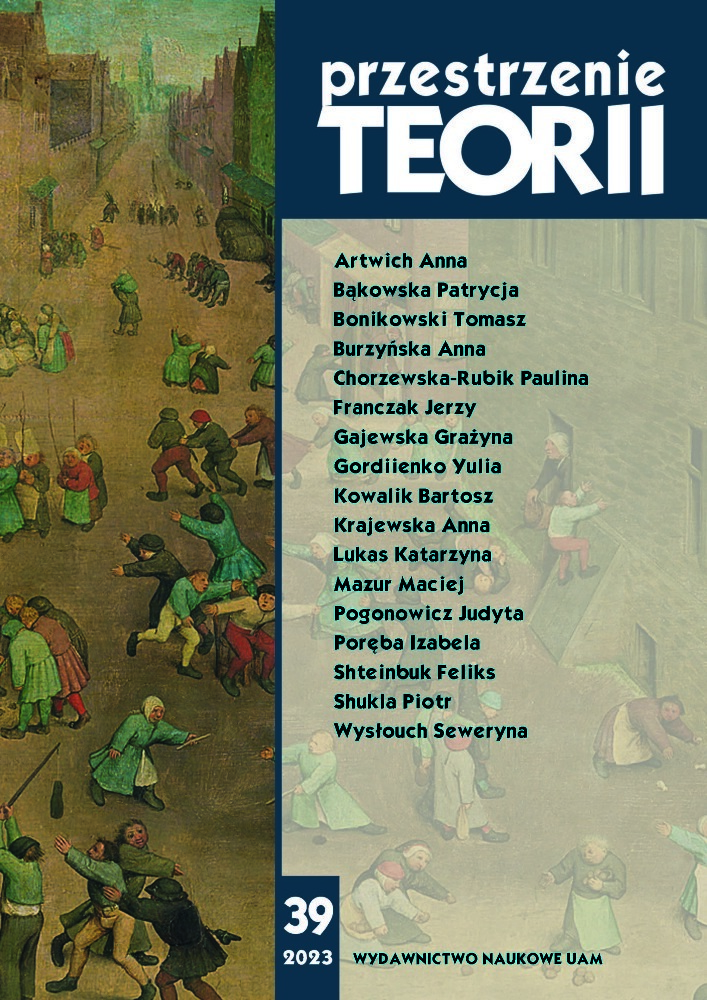Abstract
This article aims to analyze the use of parodic ekphrasis of the cathedral in Gustave Flaubert’s Madame Bovary. This matter was first brought to attention by Małgorzata Czermińska, who pointed out the satirical nature of the literary description of the gothic church in Rouen. However, to truly understand the way in which the novelist transformed the traditional formula of ekphrasis in Madame Bovary one must consider two drastically different dimensions of this treatment. The inspiration for this division comes from the work of Renata Lis, who argued that Flaubert’s work is marked by a fundamental ambivalence concerning spirituality, resulting in a variety of representations of holiness in his novels. On one hand, the parody of ekphrasis in the novel serves the most obvious function – it’s a cause for the mockery of the bourgeoisie and its distorted spiritual and aesthetic sensibilities. On the other hand, the parodic aspect of the discussed fragment is reminiscent of Olga Freudenberg’s approach. According to this Russian scholar, the essence of parody is not expressed through comedy and ridicule but rather through tragedy and an inseparable connection to the sacred. Such an understanding of the parodic ekphrasis of the gothic temple in Madame Bovary highlights the remarkable consistency with which Flaubert reflected on the existential condition of the protagonist. Emma’s inability to grasp the aesthetic values and sanctity of the cathedral expresses her tragic tendency to misrecognize, which leads to the novel’s somber finale.
References
Flaubert G., Legenda o świętym Julianie Szpitalniku, przeł. R. Lis, [w:] tegoż, Trzy baśnie, przeł. R. Lis, J.M. Rymkiewicz, Warszawa 2009, s. 57-88.
Flaubert G., Pamiętniki szaleńca. Listopad, przeł. P. Śniedziewski, Warszawa 2021.
Flaubert G., Pani Bovary. Z obyczajów prowincji, przeł. R. Engelking, Warszawa 2020.
Barthes R., Mitologie, przeł. A. Dziadek, Warszawa 2020.
Bergson H., Śmiech. Esej o komizmie, przeł. S. Cichowicz, Warszawa 1995.
Czermińska M., Gotyk i pisarze, Gdańsk 2005.
Eliade M., Sacrum a profanum, przeł. B. Baran, Warszawa 2022.
Emery E., Romancing the Cathedral: Gothic Architecture in Fin-De-Siecle French Culture, Albany 2001.
Engelking R., Przedmowa, [w:], Gustave Flaubert, Pani Bovary. Z obyczajów prowincji, przeł. R. Engelking, Warszawa 2020, s. 5-22.
Freudenberg O., Pochodzenie parodii, przeł. A. Pomorski, [w:] tejże, Semantyka kultury, red. D. Ulicka, Kraków 2009, s. 43-45.
Lis R. (oprac.), Kalendarium, [w:] Trzy baśnie, przeł. R. Lis, J.M. Rymkiewicz, Warszawa 2009, s. 221-247.
Lis R., Ręka Flauberta, Warszawa 2011.
Nabokov V., Wykłady o literaturze, przeł. Z. Batko, Warszawa 2000, s. 229.
Parandowski J., Przedmowa, [w:] G. Flaubert, Pani Bovary, przeł. A. Micińska, Warszawa 1969, s. 5-31.
Rancière J., Dlaczego należało zabić Emmę Bovary? Literatura, demokracja i medycyna, przeł. J. Franczak, „Teksty Drugie” 2012, nr 4 (136), s. 143-159.
Simson O. von, Katedra gotycka, przeł. A. Palińska, Warszawa 1989.
Śniedziewski P., Kłopoty z „początkiem” – „Herodiada” Gustawa Flauberta, „Teksty Drugie” 2007, nr 3, s. 192.
Śniedziewski P., „Uciekałem w samotność…” – figury romantycznej samotności w Pamiętnikach szaleńca i Listopadzie Gustave’a Flauberta, [w:] G. Flaubert, Pamiętniki szaleńca. Listopad, przeł. P. Śniedziewski, Warszawa 2021, s. 213-241.
Wojkiewicz R., W spektrum Wyspiańskiego. Witraż w poezji Młodej Polski, Warszawa 2022.
Wysłouch S., Literatura a sztuki wizualne, Warszawa 1994.
Ziomek J., Retoryka opisowa, Wrocław 1990.
License
Copyright (c) 2023 Piotr Shukla

This work is licensed under a Creative Commons Attribution-NonCommercial-NoDerivatives 4.0 International License.
Authors
Authors of texts accepted for publication in Przestrzenie Teorii are required to complete, sign and return to the editor's office the Agreement for granting a royalty-free license to works with a commitment to grant a CC sub-license.
Under the agreement, the authors of texts published in Przestrzenie Teorii grant the Adam Mickiewicz University in Poznań a non-exclusive, royalty-free license and authorize the use of Attribution-NonCommercial-NoDerivatives 4.0 International (CC BY-NC-ND 4.0) Creative Commons sub-license.
The authors retain the right to continue the free disposal of the work.
Users
Interested Internet users are entitled to use works published in Przestrzenie Teorii since 2015, for non-commercial purposes only, under the following conditions:
- attribution - obligation to provide, together with the distributed work, information about the authorship, title, source (link to the original work, DOI) and the license itself.
- no derivatives - the work must be preserved in its original form, without the author's consent it is not possible to distribute the modified work, such as translations, publications, etc.
Copyrights are reserved for all texts published before 2015.
Miscellaneous
Adam Mickiewicz University in Poznań retains the right to magazines as a whole (layout, graphic form, title, cover design, logo etc.).

